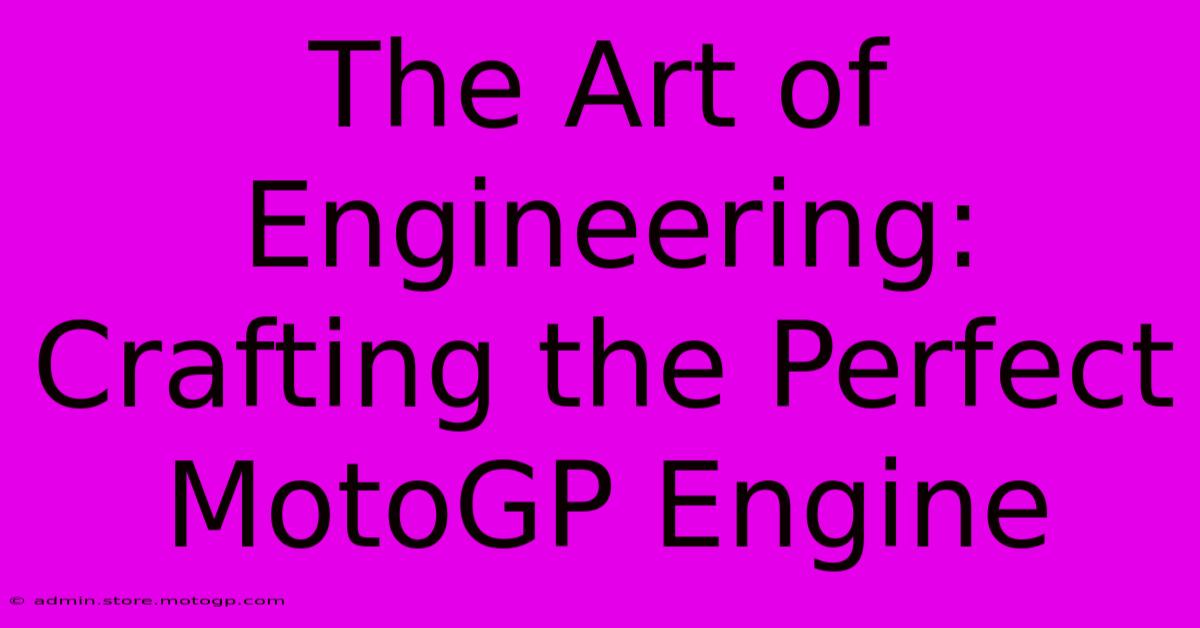The Art Of Engineering: Crafting The Perfect MotoGP Engine

Table of Contents
The Art of Engineering: Crafting the Perfect MotoGP Engine
The roar of a MotoGP engine, the shriek of tires on asphalt, the breathtaking speed—it's a symphony of power and precision. But behind the spectacle lies a masterpiece of engineering, a testament to human ingenuity and the relentless pursuit of perfection. Crafting the perfect MotoGP engine isn't just about horsepower; it's about a delicate balance of power, weight, reliability, and fuel efficiency—a true art form.
The Heart of the Beast: Engine Specifications and Design
MotoGP engines are marvels of modern engineering. We're talking about prototypical 1000cc four-stroke engines, typically inline four-cylinder configurations, though some manufacturers have experimented with V4 designs. These aren't your everyday automotive engines. They operate at screamingly high RPMs, demanding materials and designs capable of withstanding immense stress and heat.
Key Design Considerations:
- Lightweight Construction: Every gram counts in MotoGP. Engines are constructed using exotic materials like titanium, magnesium, and carbon fiber, minimizing weight while maximizing strength.
- High RPM Capability: These engines rev to incredibly high RPMs (often exceeding 18,000 RPM!), requiring precisely engineered components to withstand the immense centrifugal forces. This necessitates highly advanced balancing and vibration damping systems.
- Extreme Fuel Efficiency: Fuel consumption regulations are stringent. Engineers meticulously optimize fuel injection and combustion to maximize power while minimizing fuel usage. This involves advanced electronic fuel injection systems and sophisticated engine management units (EMUs).
- Seamless Power Delivery: The power delivery must be smooth and controllable, allowing riders to exploit the engine's full potential without losing control. This involves careful tuning of the engine's power curve and the use of sophisticated traction control systems.
- Aerodynamics: Even the engine's design contributes to the overall aerodynamics of the motorcycle. Compactness and strategic placement are crucial for minimizing drag and maximizing downforce.
Beyond the Engine: The Supporting Cast
The engine is only one component of the high-performance system. Its success is intrinsically linked to other critical aspects:
1. Seamless Transmission:
A flawlessly functioning transmission is essential for rapid acceleration and precise gear changes during intense racing conditions. Seamless, quick-shifting gearboxes are critical for maintaining momentum and optimizing lap times.
2. Sophisticated Electronics:
Modern MotoGP bikes are heavily reliant on sophisticated electronics. Traction control, wheelie control, launch control, and engine braking systems are all crucial for maximizing performance and rider safety. These systems rely on incredibly advanced sensors and algorithms that constantly monitor and adjust the engine's behavior.
3. Tire Technology:
The tires themselves are highly specialized, designed to provide optimal grip and performance under extreme conditions. The interaction between the engine's power delivery and the tire's grip is critical for achieving maximum speed and acceleration.
The Ongoing Evolution: Innovation and the Future of MotoGP Engines
The quest for the perfect MotoGP engine is an ongoing process. Manufacturers constantly push the boundaries of engineering, experimenting with new materials, designs, and technologies. We can expect to see continued innovations in areas like:
- Hybrid Technology: The incorporation of hybrid systems could further enhance fuel efficiency and power delivery.
- Advanced Materials: The development of even lighter and stronger materials will continue to improve performance.
- Artificial Intelligence: AI-powered engine management systems could optimize engine performance in real-time based on track conditions and rider input.
The art of engineering a MotoGP engine is a captivating blend of science, technology, and artistry. It demands an unwavering commitment to innovation, precision, and the relentless pursuit of perfection. The result is a symphony of power and precision that pushes the boundaries of what's possible.

Thank you for visiting our website wich cover about The Art Of Engineering: Crafting The Perfect MotoGP Engine. We hope the information provided has been useful to you. Feel free to contact us if you have any questions or need further assistance. See you next time and dont miss to bookmark.
Featured Posts
-
Race Bikes For Sale Explore The Open Road
Feb 19, 2025
-
Malaysian Motorcycle Grand Prix Fuel Your Passion For Racing
Feb 19, 2025
-
The Importance Of Qualifying In The Moto Gp Points System
Feb 19, 2025
-
The Price Of Glory The Sacrifices Of The Best Moto Gp Riders
Feb 19, 2025
-
Motorcycle Grand Prix Winners The Ultimate Racing Guide
Feb 19, 2025
